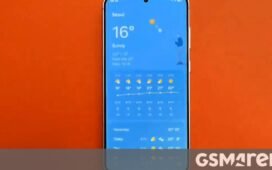In addition to the Galaxy Ring, Samsung expanded its smart wearable lineup with the Galaxy Watch7 and Galaxy Watch Ultra.
The Ultra comes in a single 47mm size, while the Galaxy Watch7 has the usual 40mm and 44mm options. Sadly, none of the watches has a rotating bezel, meaning there is no Classic model this year.
The Galaxy Watch Ultra (not the Watch7 Ultra, mind) is Samsung’s answer to the Apple Watch Ultra series and has a lot in common with it, starting with the way it looks. It’s a more robust-looking timepiece with what Samsung has dubbed a cushion design. It’s a rectangle housing a circled watch face and bezel. There are three buttons on the side of the Galaxy Watch Ultra with the middle being a Quick Button with extra functionality.

The Galaxy Watch Ultra comes in a single 47mm size with a 47mm diameter 1.5-inch 480x480px Super AMOLED display with up to 3,000 nits of peak brightness. The display sits snugly under a sapphire crystal top, so scratches shouldn’t be an issue. The casing uses titanium Grade 4 and weighs 60.5g.
The Galaxy Watch Ultra is a truely rugged beast with 10ATM, IP68, and MIL-STD-810H certification for water, dust and shock resistance. Additionally, it can withstand temperatures between +55° and -20° and survive at up to 9000 meters above sea level and down to -500 meters below.
The watch has a 590mAh battery, the same power pack as the Galaxy Watch5 Pro from a few years ago. It gives the Galaxy Watch Ultra the longest battery life in the Galaxy Watch lineup – up to 100 hours in Power Saving mode and 48 hours in Exercise Power Saving.

Inside, the Galaxy Watch Ultra packs the new Exynos W1000 – a 3nm chip with a 3 times faster CPU than the W930 and 2GB of RAM. Samsung says the new chip is 30% more efficient.
Samsung’s new watch also finally embraces dual-frequency GPS for more precise tracking, even in dense urban environments.
The Galaxy Watch Ultra can track 100 sports and multi-course workouts – essentially different activities as a combined workout. The Watch Ultra also brings FTP index tracking or Functional Threshold Power. It’s a cycling-focused measurement of your maximum cycling power.
For runners, there’s a new Race mode, which can compare your current performance to your past one in real time – this only works for outdoor running, mind.
The Galaxy Watch Ultra brings AI-enhanced tracking algorithms alongside an enhanced BioActive Sensor. Sleep analysis is better thanks to a new Sleep Apnea support that will check if you have the condition, based on abnormally high or low heart rates. Speaking of heart rate – the new watches can scan for irregular rhythms that are suggestive of atrial fibrillation. The ECG and blood pressure monitoring are still here, as is the skin temperature sensor used for period projection.
Finally, the new Galaxy Watch Ultra and Galaxy Watch7 can do advanced glycation tracking to monitor your sugar levels. They then give you an AGEs Index – a biological aging process index to give you insight into your metabolic health.

The Galaxy Watch7 shares all of these advanced fitness and health metrics. It also shares the sapphire crystal glass, the new BioActive sensor, and the Exynos W1000 5-core chip.
Here, you get a choice of two sizes – a 40mm with a 1.3-inch 432×432 Super AMOLED display and a 44mm with a 1.5-inch 480x480px screen – the same as the Ultra. And while the Galaxy Watch7 can’t go up the tallest mountains and isn’t suitable to deep diving, it matches the Galaxy Watch Ultra’s MIL-STD-810H along with a 5ATM + IP68 rating.

Both smartwatches lay exclusive claim to Wear OS 5 (until the Pixel Watch 3 launches in August), and run Samsung’s One UI 6 Watch.

The Galaxy Watch7 and Galaxy Watch Ultra are up for pre-order starting today and will begin shipping on July 24. The Galaxy Watch7 starts at €319/$300 for the 40mm (Green and Cream) Bluetooth model and goes up to €349/$330 for the 44mm (Green and Silver). The Galaxy Watch Ultra comes in Titanium Gray, Titanium White, and Titanium Silver and in a single Bluetooth + 4G config, priced at €699/$650.

















